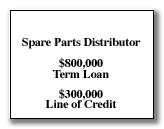|
Financing Challenge:
 A distributor of spare parts became a victim of Lender Fatigue. The Company was financed by an Asset Based Lender that advanced funds against eligible accounts receivable and inventory. The recession adversely affected the Company, reducing revenue from $8.4 million in 2008 to $6 million in 2009.
The lender became very concerned that the Company's customers might not satisfy their obligations and reduced the availability on accounts receivable from 90 days to 70 days. To make matters worst, the lender also decided that accounts receivable from certain customers were ineligible, thus reducing the Company's availability to borrow. A distributor of spare parts became a victim of Lender Fatigue. The Company was financed by an Asset Based Lender that advanced funds against eligible accounts receivable and inventory. The recession adversely affected the Company, reducing revenue from $8.4 million in 2008 to $6 million in 2009.
The lender became very concerned that the Company's customers might not satisfy their obligations and reduced the availability on accounts receivable from 90 days to 70 days. To make matters worst, the lender also decided that accounts receivable from certain customers were ineligible, thus reducing the Company's availability to borrow.
An incident then occurred that almost caused the Company to lose its largest customer. A large publicly held company placed a large order for which the Company requested a deposit which was to be used to prepay the Company's vendor who requested 50% in advance for this large order. When the Company received the deposit from their customer, the lender applied this payment against other open accounts receivable instead of allowing the Company to use the funds to pay the deposit to their vendor. The Company argued with the lender who would not change its position. The Company's principals searched for additional funds and eventually used their retirement funds to pay the vendor.
The Company's current lender then decided to transition its business to larger companies and asked the Company to find a new lender.
The Company received a proposal from another Asset Based Lender who proposed an effective interest rate of 16%, but without the ability to borrow against inventory. The inability to borrow against inventory would significantly affect the Company's liquidity. The Company hoped to find a less expensive and more flexible alternative.
The Company was referred by its outside CPA firm to Asset Enhancement Solutions, LLC for assistance.
Creative Financing Solution:
Asset Enhancement Solutions, LLC ("AES") found that the Company was in Technical Default with its current lender and paying an interest rate of 15%, instead of the10% effective rate it would have been paying had it not been in default. The Company had negative net worth of approximately $100,000 and the principals had no personal assets to secure a loan other than a small amount of equity in their personal residence.
Although the Company had a negative net worth, with guidance from its outside CPA firm it significantly reduced expenses in 2009 and ended the year with a profit of $298,000 which brought its negative net worth from $(367,000) at 12/31/08 to ($70,000) at 12/31/09. The Company projected net income of $560,000 on sales of $8.4 million for the year ended 12/31/10.
Based on the favorable 2009 results and 2010 projections, AES was able to arrange a credit facility of $1,100,000 for the Company consisting of a Term Loan of $800,000 and a Line of Credit of $300,000. The interest rate for this facility was 6% with an amortization period of 7 years. The Company was not required to maintain a lockbox as was required by its previous Asset Based Lender.
The new $1,100,000 credit facility gave the Company the working capital and flexibility it needed to operate and grow its business.
Contact
Neil Seiden, 516-767-0100
neil.seiden@assetenhancement.com
<< Back to index
| 
